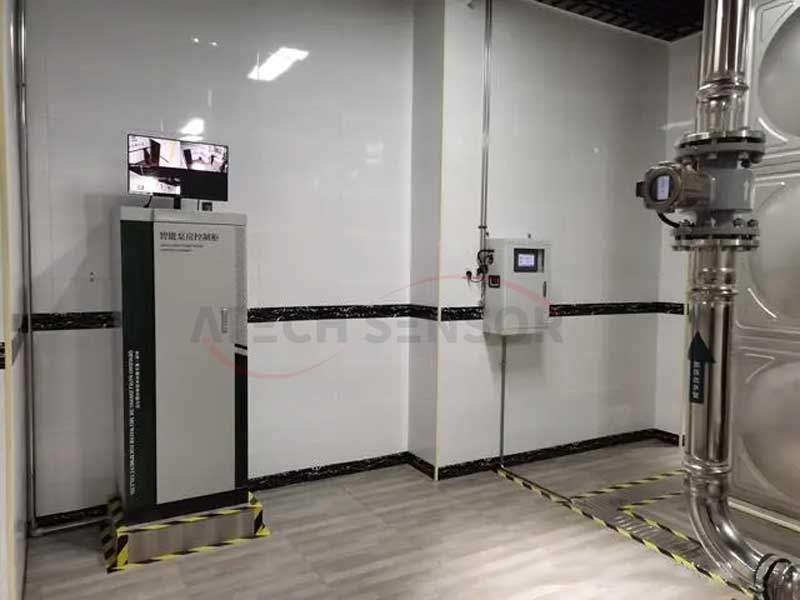The water quality monitoring system is a technical device used to monitor and analyze water quality in real time. It plays a vital role in water resource management, environmental protection, public health and other fields. The following is a detailed introduction to the water quality monitoring system:
1. System composition
Sensor
Sensor is the core component of water quality monitoring system, which can directly measure various physical, chemical and biological parameters in water. Common sensors include temperature sensor, pH sensor, dissolved oxygen sensor, conductivity sensor, turbidity sensor, ammonia nitrogen sensor, heavy metal sensor, etc. These sensors can be combined according to different monitoring needs to achieve comprehensive monitoring of water quality.
For example, in the water quality monitoring of drinking water sources, temperature, pH value, dissolved oxygen, turbidity and other sensors are usually installed to ensure the safety of drinking water; in the water quality monitoring of industrial wastewater outlets, ammonia nitrogen, heavy metal and other sensors need to be installed to monitor the pollution degree of wastewater.
Data collector
The data collector is responsible for collecting, storing and transmitting the data measured by the sensor. It usually has multiple input channels, can connect multiple sensors, and can condition and convert the sensor signals to meet the requirements of data collection. The data collector can also be equipped with a wireless communication module to transmit the collected data to the remote monitoring center in real time so that managers can understand the water quality status in time.
For example, some advanced data collectors can transmit data to the cloud server through wireless communication networks such as GPRS, 3G, and 4G to achieve remote monitoring and data analysis.
Remote Monitoring Center
The remote monitoring center is the management and control center of the water quality monitoring system. It is usually composed of computers, servers, databases and monitoring software. The remote monitoring center can receive data from various monitoring sites, store, analyze and process the data, and generate various reports and charts for managers to make decisions. The remote monitoring center can also remotely control and manage the equipment at the monitoring site, such as setting sensor parameters, starting and stopping data collectors, etc.
For example, managers can view the water quality data of each monitoring site in real time through the remote monitoring center. When abnormal water quality is found, timely measures can be taken to deal with it, such as notifying relevant departments to conduct on-site inspections and starting emergency treatment equipment.

2. Monitoring parameters
Physical parameters
Temperature: Water temperature is one of the important factors affecting biological activities and chemical reactions in water bodies. Different aquatic organisms have different adaptation ranges to water temperature. Too high or too low water temperature will affect aquatic organisms. In addition, water temperature can also reflect the degree of thermal pollution of water bodies.
Turbidity: Turbidity refers to the degree of obstruction caused by suspended matter in water to the transmission of light. The higher the turbidity, the more suspended matter in the water and the worse the water quality. Turbidity can be measured by turbidity sensors, and the unit is usually NTU (scattered turbidity unit).
Chroma: Chroma refers to the depth of color of water bodies. Chroma is mainly caused by soluble substances and suspended matter in water, such as humus, iron, manganese, etc. Chroma can be measured by colorimetry, and the unit is usually degrees.
Chemical parameters
pH value: pH value refers to the acidity and alkalinity of water, which reflects the concentration of hydrogen ions in the water. pH value has an important impact on the survival and growth of aquatic organisms, and different aquatic organisms have different adaptability ranges to pH values. pH value can be measured by pH sensors, and the range is usually 0-14.
Dissolved oxygen: Dissolved oxygen refers to the content of oxygen molecules dissolved in water. Dissolved oxygen is a substance necessary for the survival of aquatic organisms, and its content directly affects the respiration and metabolism of aquatic organisms. Dissolved oxygen can be measured by dissolved oxygen sensors, and the unit is usually mg/L (milligrams per liter).
Conductivity: Conductivity refers to the content of conductive substances in water, which reflects the salt content and ion concentration of the water. Conductivity can be measured by conductivity sensors, and the unit is usually μS/cm (microsiemens per centimeter).
Ammonia nitrogen: Ammonia nitrogen refers to nitrogen in the form of free ammonia (NH3) and ammonium ions (NH4+) in water. Ammonia nitrogen is an important pollutant in water bodies. It mainly comes from domestic sewage, industrial wastewater and agricultural non-point source pollution. Ammonia nitrogen can be measured by ammonia nitrogen sensor, and the unit is usually mg/L.
Heavy metals: Heavy metals refer to metal elements with a density greater than 5g/cm³, such as mercury, cadmium, lead, chromium, etc. Heavy metals are highly toxic and stable in water bodies. They can accumulate in organisms through the food chain and cause harm to human health. Heavy metals can be measured by atomic absorption spectroscopy, inductively coupled plasma mass spectrometry and other methods, and the unit is usually mg/L.
Biological parameters
Chlorophyll a: Chlorophyll a is an important pigment in phytoplankton, and its content can reflect the biomass of phytoplankton in the water body. Chlorophyll a can be measured by fluorescence method, and the unit is usually μg/L (micrograms/liter).
Total bacteria: The total bacteria refers to the number of bacteria contained in each milliliter of water sample. The total bacteria can reflect the sanitary condition and pollution degree of the water body. The total bacteria can be measured by plate count method, and the unit is usually /mL (pieces/milliliter).
Escherichia coli group: Escherichia coli group refers to a group of Gram-negative non-spore-forming bacilli that can ferment lactose, produce acid and gas, and are aerobic and facultative anaerobic when cultured at 37℃ for 24 hours. Escherichia coli group is a common indicator bacteria in water bodies, and its content can reflect the degree of fecal pollution in water bodies. Escherichia coli group can be measured by multi-tube fermentation method, and the unit is usually /L.

3. Application Fields
Water Resource Management
The water quality monitoring system can monitor natural water bodies such as rivers, lakes, and reservoirs in real time, understand the water quality status and changing trends of water bodies, and provide a scientific basis for the rational development, utilization, and protection of water resources. For example, by monitoring the water quality of drinking water sources, water pollution problems can be discovered in a timely manner, and corresponding protective measures can be taken to ensure the safety of drinking water.
The water quality monitoring system can also monitor the urban water supply system, understand the status of water quality, and ensure the safety of drinking water for urban residents. For example, by installing water quality monitoring equipment in the urban water supply network, the water quality parameters of the water supply, such as residual chlorine, turbidity, pH value, etc., can be monitored in real time. When abnormal water quality is found, timely measures can be taken to deal with it, such as adjusting the dosage and cleaning the pipeline.
Environmental protection
The water quality monitoring system can monitor the discharge outlets of industrial wastewater, domestic sewage, etc., understand the pollution degree of wastewater, and ensure that the wastewater meets the discharge standards. For example, by installing water quality monitoring equipment at the discharge outlets of industrial wastewater, the water quality parameters of wastewater, such as ammonia nitrogen, heavy metals, etc., can be monitored in real time. When it is found that the wastewater exceeds the discharge standard, the relevant departments can be notified in time for treatment to prevent pollution to the environment.
The water quality monitoring system can also monitor water bodies such as oceans and rivers to understand the ecological environment of water bodies and provide a scientific basis for environmental protection and ecological restoration. For example, by monitoring the water quality of the ocean, the pollution degree and ecological environment of the ocean can be understood, providing a scientific basis for marine environmental protection and ecological restoration.
Public health
The water quality monitoring system can monitor the water quality of public places such as swimming pools and hot springs, understand the sanitary conditions of water quality, and ensure the health and safety of the public. For example, by installing water quality monitoring equipment in swimming pools, the residual chlorine, pH value, turbidity and other parameters of swimming pool water can be monitored in real time. When the water quality is found to be substandard, timely measures can be taken to deal with it, such as adding disinfectants, adjusting pH values, etc.
The water quality monitoring system can also monitor drinking water, food processing water, etc., understand the sanitary conditions of water quality, and ensure the food safety of the public. For example, by installing water quality monitoring equipment in drinking water plants, food processing plants and other places, water quality parameters such as residual chlorine, total bacteria, E. coli group, etc. can be monitored in real time. When the water quality is found to be substandard, timely measures can be taken to deal with it, such as changing the water source and strengthening disinfection.

4. Development Trend
Intelligence
With the development of technologies such as artificial intelligence, the Internet of Things, and big data, water quality monitoring systems will become more and more intelligent. The future water quality monitoring system will be able to realize functions such as automatic monitoring, automatic analysis, automatic warning, and automatic control, greatly improving the efficiency and accuracy of water quality monitoring. For example, by installing intelligent sensors and data analysis software, real-time monitoring and analysis of water quality can be achieved. When abnormal water quality is found, early warning information can be automatically issued, and corresponding control measures can be taken, such as closing valves and starting emergency treatment equipment.
Miniaturization
In order to meet the needs of different application scenarios, water quality monitoring systems will become more and more miniaturized. The future water quality monitoring system will be able to achieve portability, miniaturization, and integration, making it convenient for users to monitor water quality in different occasions. For example, by adopting microfluidics technology, nanotechnology, etc., water quality monitoring equipment can be integrated into a small chip to achieve fast and accurate monitoring of water quality.
Multi-parameterization
In order to fully understand the water quality of water bodies, water quality monitoring systems will become more and more parameterized. Future water quality monitoring systems will be able to simultaneously measure multiple water quality parameters, such as physical parameters, chemical parameters, biological parameters, etc., to provide more comprehensive information for water quality evaluation and management. For example, by adopting multi-sensor fusion technology, spectral analysis technology, etc., multi-parameter measurement of water quality can be achieved to improve the accuracy and reliability of water quality monitoring.
In short, the water quality monitoring system is a very important technical equipment, which plays a vital role in water resources management, environmental protection and public health. With the continuous advancement of technology, water quality monitoring systems will become more and more intelligent, miniaturized and multi-parameterized, providing more efficient, accurate and comprehensive services for water quality monitoring and management.

